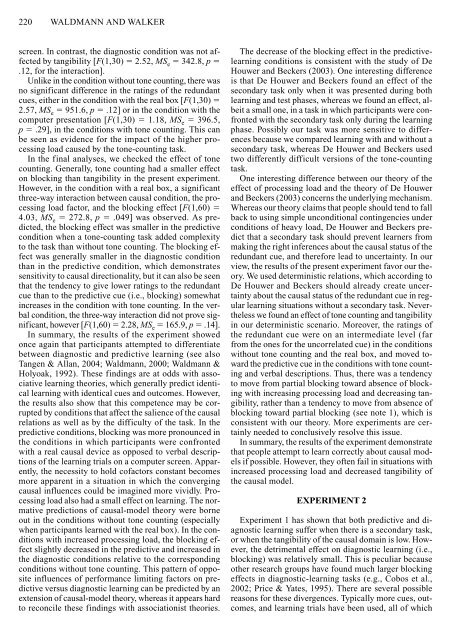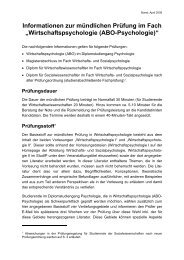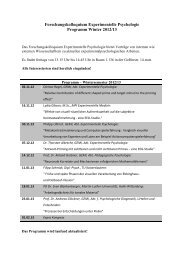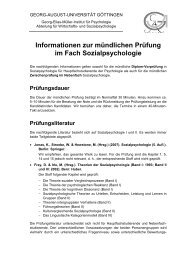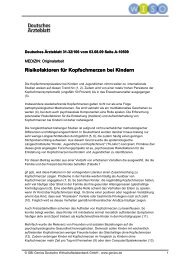Competence and performance in causal learning
Competence and performance in causal learning
Competence and performance in causal learning
You also want an ePaper? Increase the reach of your titles
YUMPU automatically turns print PDFs into web optimized ePapers that Google loves.
220 WALDMANN AND WALKER<br />
screen. In contrast, the diagnostic condition was not affected<br />
by tangibility [F(1,30) 2.52, MS e 342.8, p <br />
.12, for the <strong>in</strong>teraction].<br />
Unlike <strong>in</strong> the condition without tone count<strong>in</strong>g, there was<br />
no significant difference <strong>in</strong> the rat<strong>in</strong>gs of the redundant<br />
cues, either <strong>in</strong> the condition with the real box [F(1,30) <br />
2.57, MS e 951.6, p .12] or <strong>in</strong> the condition with the<br />
computer presentation [F(1,30) 1.18, MS e 396.5,<br />
p .29], <strong>in</strong> the conditions with tone count<strong>in</strong>g. This can<br />
be seen as evidence for the impact of the higher process<strong>in</strong>g<br />
load caused by the tone-count<strong>in</strong>g task.<br />
In the f<strong>in</strong>al analyses, we checked the effect of tone<br />
count<strong>in</strong>g. Generally, tone count<strong>in</strong>g had a smaller effect<br />
on block<strong>in</strong>g than tangibility <strong>in</strong> the present experiment.<br />
However, <strong>in</strong> the condition with a real box, a significant<br />
three-way <strong>in</strong>teraction between <strong>causal</strong> condition, the process<strong>in</strong>g<br />
load factor, <strong>and</strong> the block<strong>in</strong>g effect [F(1,60) <br />
4.03, MS e 272.8, p .049] was observed. As predicted,<br />
the block<strong>in</strong>g effect was smaller <strong>in</strong> the predictive<br />
condition when a tone-count<strong>in</strong>g task added complexity<br />
to the task than without tone count<strong>in</strong>g. The block<strong>in</strong>g effect<br />
was generally smaller <strong>in</strong> the diagnostic condition<br />
than <strong>in</strong> the predictive condition, which demonstrates<br />
sensitivity to <strong>causal</strong> directionality, but it can also be seen<br />
that the tendency to give lower rat<strong>in</strong>gs to the redundant<br />
cue than to the predictive cue (i.e., block<strong>in</strong>g) somewhat<br />
<strong>in</strong>creases <strong>in</strong> the condition with tone count<strong>in</strong>g. In the verbal<br />
condition, the three-way <strong>in</strong>teraction did not prove significant,<br />
however [F(1,60) 2.28, MS e 165.9, p .14].<br />
In summary, the results of the experiment showed<br />
once aga<strong>in</strong> that participants attempted to differentiate<br />
between diagnostic <strong>and</strong> predictive learn<strong>in</strong>g (see also<br />
Tangen & Allan, 2004; Waldmann, 2000; Waldmann &<br />
Holyoak, 1992). These f<strong>in</strong>d<strong>in</strong>gs are at odds with associative<br />
learn<strong>in</strong>g theories, which generally predict identical<br />
learn<strong>in</strong>g with identical cues <strong>and</strong> outcomes. However,<br />
the results also show that this competence may be corrupted<br />
by conditions that affect the salience of the <strong>causal</strong><br />
relations as well as by the difficulty of the task. In the<br />
predictive conditions, block<strong>in</strong>g was more pronounced <strong>in</strong><br />
the conditions <strong>in</strong> which participants were confronted<br />
with a real <strong>causal</strong> device as opposed to verbal descriptions<br />
of the learn<strong>in</strong>g trials on a computer screen. Apparently,<br />
the necessity to hold cofactors constant becomes<br />
more apparent <strong>in</strong> a situation <strong>in</strong> which the converg<strong>in</strong>g<br />
<strong>causal</strong> <strong>in</strong>fluences could be imag<strong>in</strong>ed more vividly. Process<strong>in</strong>g<br />
load also had a small effect on learn<strong>in</strong>g. The normative<br />
predictions of <strong>causal</strong>-model theory were borne<br />
out <strong>in</strong> the conditions without tone count<strong>in</strong>g (especially<br />
when participants learned with the real box). In the conditions<br />
with <strong>in</strong>creased process<strong>in</strong>g load, the block<strong>in</strong>g effect<br />
slightly decreased <strong>in</strong> the predictive <strong>and</strong> <strong>in</strong>creased <strong>in</strong><br />
the diagnostic conditions relative to the correspond<strong>in</strong>g<br />
conditions without tone count<strong>in</strong>g. This pattern of opposite<br />
<strong>in</strong>fluences of <strong>performance</strong> limit<strong>in</strong>g factors on predictive<br />
versus diagnostic learn<strong>in</strong>g can be predicted by an<br />
extension of <strong>causal</strong>-model theory, whereas it appears hard<br />
to reconcile these f<strong>in</strong>d<strong>in</strong>gs with associationist theories.<br />
The decrease of the block<strong>in</strong>g effect <strong>in</strong> the predictivelearn<strong>in</strong>g<br />
conditions is consistent with the study of De<br />
Houwer <strong>and</strong> Beckers (2003). One <strong>in</strong>terest<strong>in</strong>g difference<br />
is that De Houwer <strong>and</strong> Beckers found an effect of the<br />
secondary task only when it was presented dur<strong>in</strong>g both<br />
learn<strong>in</strong>g <strong>and</strong> test phases, whereas we found an effect, albeit<br />
a small one, <strong>in</strong> a task <strong>in</strong> which participants were confronted<br />
with the secondary task only dur<strong>in</strong>g the learn<strong>in</strong>g<br />
phase. Possibly our task was more sensitive to differences<br />
because we compared learn<strong>in</strong>g with <strong>and</strong> without a<br />
secondary task, whereas De Houwer <strong>and</strong> Beckers used<br />
two differently difficult versions of the tone-count<strong>in</strong>g<br />
task.<br />
One <strong>in</strong>terest<strong>in</strong>g difference between our theory of the<br />
effect of process<strong>in</strong>g load <strong>and</strong> the theory of De Houwer<br />
<strong>and</strong> Beckers (2003) concerns the underly<strong>in</strong>g mechanism.<br />
Whereas our theory claims that people should tend to fall<br />
back to us<strong>in</strong>g simple unconditional cont<strong>in</strong>gencies under<br />
conditions of heavy load, De Houwer <strong>and</strong> Beckers predict<br />
that a secondary task should prevent learners from<br />
mak<strong>in</strong>g the right <strong>in</strong>ferences about the <strong>causal</strong> status of the<br />
redundant cue, <strong>and</strong> therefore lead to uncerta<strong>in</strong>ty. In our<br />
view, the results of the present experiment favor our theory.<br />
We used determ<strong>in</strong>istic relations, which accord<strong>in</strong>g to<br />
De Houwer <strong>and</strong> Beckers should already create uncerta<strong>in</strong>ty<br />
about the <strong>causal</strong> status of the redundant cue <strong>in</strong> regular<br />
learn<strong>in</strong>g situations without a secondary task. Nevertheless<br />
we found an effect of tone count<strong>in</strong>g <strong>and</strong> tangibility<br />
<strong>in</strong> our determ<strong>in</strong>istic scenario. Moreover, the rat<strong>in</strong>gs of<br />
the redundant cue were on an <strong>in</strong>termediate level (far<br />
from the ones for the uncorrelated cue) <strong>in</strong> the conditions<br />
without tone count<strong>in</strong>g <strong>and</strong> the real box, <strong>and</strong> moved toward<br />
the predictive cue <strong>in</strong> the conditions with tone count<strong>in</strong>g<br />
<strong>and</strong> verbal descriptions. Thus, there was a tendency<br />
to move from partial block<strong>in</strong>g toward absence of block<strong>in</strong>g<br />
with <strong>in</strong>creas<strong>in</strong>g process<strong>in</strong>g load <strong>and</strong> decreas<strong>in</strong>g tangibility,<br />
rather than a tendency to move from absence of<br />
block<strong>in</strong>g toward partial block<strong>in</strong>g (see note 1), which is<br />
consistent with our theory. More experiments are certa<strong>in</strong>ly<br />
needed to conclusively resolve this issue.<br />
In summary, the results of the experiment demonstrate<br />
that people attempt to learn correctly about <strong>causal</strong> models<br />
if possible. However, they often fail <strong>in</strong> situations with<br />
<strong>in</strong>creased process<strong>in</strong>g load <strong>and</strong> decreased tangibility of<br />
the <strong>causal</strong> model.<br />
EXPERIMENT 2<br />
Experiment 1 has shown that both predictive <strong>and</strong> diagnostic<br />
learn<strong>in</strong>g suffer when there is a secondary task,<br />
or when the tangibility of the <strong>causal</strong> doma<strong>in</strong> is low. However,<br />
the detrimental effect on diagnostic learn<strong>in</strong>g (i.e.,<br />
block<strong>in</strong>g) was relatively small. This is peculiar because<br />
other research groups have found much larger block<strong>in</strong>g<br />
effects <strong>in</strong> diagnostic-learn<strong>in</strong>g tasks (e.g., Cobos et al.,<br />
2002; Price & Yates, 1995). There are several possible<br />
reasons for these divergences. Typically more cues, outcomes,<br />
<strong>and</strong> learn<strong>in</strong>g trials have been used, all of which


